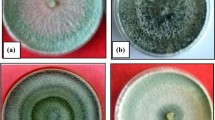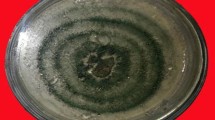Abstract
Salt stress is one of the major abiotic stresses limiting crop growth and productivity. This work investigated the potential of five ST isolates of Trichoderma harzianum (Th-13, Th-14, Th-19, Th-33 and Th-50) applied through seed biopriming in reducing the detrimental effects of salinity stress on wheat (Triticum aestivum L.). Growth, physiological and biochemical parameters were studied to characterize salt tolerance. One factor was treatments (T1, T2, T3, T4, T5 and T6) and second factor was four levels of salt stress viz., 0, 2, 4 and 6 dsm−1. In germination test, most of the isolates (Th-14, Th-19 and Th-13) were effective in improving germination percentage and reducing RPG during salinity stress. Seedlings raised from ST Trichoderma isolates had significantly higher root and shoot lengths, CC and MSI than control at all stress levels. The treatments Th-14, Th-19 and Th-13 showed lower accumulation of MDA content whereas proline content and phenolics were higher in treated plants under both non-saline and saline conditions. Highest MDA content was observed in control at salt stress level of 6 dSm−1. It is concluded that seed biopriming with different salinity tolerant isolates of Trichoderma reduced severity of the effects of salinity though the amelioration was better in Th-14 under present experimental material and conditions.


Similar content being viewed by others
Abbreviations
- ST:
-
Salinity tolerant
- RPG:
-
Reduction percentage of germination
- CC:
-
Chlorophyll content
- MSI:
-
Membrane stability index
- MDA:
-
Malondialdehyde
References
Afzal I, Basra SMA, Farooq M, Nawaz A (2006) Alleviation of salinity stress in spring wheat by hormonal priming with ABA, salicylic acid and ascorbic acid. Int J Agri Biol 8:23–28
Akbar M, Ponnamperuma FN (1982) Saline soil of South and Southeast Asia potential rice lands. In: Riche Strategies for the Future. IRRI, Los Banos, Philippines, pp 265-281
Alam MZ, Stuchbury T, Naylor REL, Rashid MA (2004) Effect of salinity on growth of some modern rice cultivars. J Agron 3:1–10
Arora DK, Elander RP, Mukherji KG (1992) In: Fungal biotechnology. Handbook of applied mycology. Markel Dekker, New York, p 4
Ashraf M, O’leary JM (1997) Ion distribution in leaves of salt-tolerant and salt-sensitive lines of spring wheat under salt stress. Acta Bot Neerl 46:207–217
Bailly C, Benamar A, Corbineau F, Cone D (1996) Changes in malondialdehyde content and in superoxide dismutase, catalase and glutathione reductase activities in sunflower seeds as related to deterioration during accelerated aging. Physiol Plant 97:104–110
Barnes JD, Balaguer L, Manrigue E, Elivira S, Davison AW (1992) A reappraisal of the use of DMSO for the extraction of chlorophyll a and b in lichens and higher plants. Environ Exp Bot 32:85–90
Bates LS, Waldron RP, Teare ID (1973) Rapid determination of free proline in water stress studies. Plant Soil 29:205–208
Bear FE (1965) Chemistry of the soil. Oxford IBH Publishing, New Delhi, p 501
Benitez T, Rincon AM, Limon MC, Codon AC (2004) Biocontrol mechanisms of Trichoderma strains. Int Microbiol 7:249–260
Bohnert HJ, Jensen RG (1996) Strategies for engineering water stress tolerance in plants. Trends Biotechnol 14:89–97
Bor M, Ozdemir F, Turkan I (2003) The effect of salt stress on lipid peroxidation and antioxidants in leaves of sugar beet Beta vulgaris L. and wild beet Beta maritime L. Plant Sci 164:77–84
Botia P, Navarro JM, Cerda A, Martinez V (2005) Yield and fruit quality of two melon cultivars irrigated with saline water at different stage of development. Eur J Agron 23:243–253
Cardona R, Rodriguez H (2006) Effects of Trichoderma harzianum fungus on the incidence of the charcoal rot disease on sesame. Rev Fac Agron (LUZ) 23:42–47
Dionisio-Sese ML, Tobita S (1998) Antioxidant responses of rice seedlings to salinity stress. Plant Sci Limerick 135:1–9
Dubey SK, Maurya IZ (2003) Studies on heterosis and combining ability in bottle gourd. Indian J Genet Plant Breed 63:148–152
Gachomo EW, Kotchoni SO (2008) The use of T. harzianum and T. viride as potential biocontrol agents against peanut microflora and their effectiveness in reducing aflatoxin contamination of infected kernels. Biotechnology 7:439–447
Gadallah MAA (1999) Effect of proline and glycine-betaine on Vicia faba in response to salt stress. Biol Plant 42:247–249
Garg BK, Gupta IC (1997) Plant relations to salinity. In: Saline wastelands environment and plant growth. Scientific Publishers, Jodhpur, pp 79–121
Ghoulam C, Ahmed F, Khalid F (2002) Effects of salt stress on growth, inorganic ions and proline accumulation in relation to osmotic adjustment in five sugar beet cultivars. Environ Exp Bot 47:39–50
Gomez KA, Gomez AA (1984) Statistical procedures for agricultural research. Wiley, New York
Greenway H, Munns H (1980) Mechanisms of salt tolerance in nonhalophytes. Annu Rev Plant Physiol 31:149–190
Grieve CM, Suarez DL (1997) Purslane (Portulaca oleracea L.): a halophytic crop for drainage water reuse systems. Plant and Soil 192:277–283
Hadas A (1977) Water uptake and germination of leguminous seeds in soils of changing matrix and osmotic water potential. J Exp Bot 28:977–985
Hamada AM, EL-Enany AE (1994) Effect of NaCl salinity on growth, pigment and mineral element contents, and gas exchange of broad bean and pea plants. Biologia Plantarum 36:75–81
Harman GE (2006) Overview of mechanisms and uses of Trichoderma spp. Phytopathology 96:190–194
Harman GE, Howell CR, Vitarbo A, Chet I, Lorito M (2004) Trichoderma species –opportunistic, avirulent plant symbionts. Nature Rev Microbiol 2:43–56
Heath RL, Packer L (1968) Photoperoxidation in isolated chloroplasts: Kinetics and stoichiometry of fatty acid peroxidation. Arch Biochem Biophys 125:189–198
Hernandez JA, Mullineaux P, Sevilla F (2000) Tolerance of pea (Pisum sativum L.) to long term stress is associated with induction of antioxidant defences. Plant Cell Environ 23:853–862
Hoitink HAJ, Madden LV, Dorrance AE (2006) Systemic resistance induced by Trichoderma spp.: Interactions between the host, the pathogen, the biocontrol agent, and soil organic matter quality. Phytopathology 96:186–189
Hong ZL, Lakkineni K, Zhang ZM, Verma DPS (2000) Removal of feedback inhibition of delta (1)-pyrroline-5-carboxylate synthetase results in increased proline accumulation and protection of plants from osmotic stress. Plant Physiol 122:1129–1136
Howell CR (2003) Mechanisms employed by Trichoderma species in the biological control of plant diseases: the history and evolution of current concepts. Plant Dis 87:4–10
Kaya C, Higgs D, Ince F, Amador BM, Cakir A, Sakar E (2003) Ameliorative effects of potassium phosphate on salt stressed pepper and cucumber. J Plant Nutr 26:807–820
Khan MH, Panda SK (2008) Alterations in root lipid peroxidation and antioxidative responses in two rice cultivars under NaCl-salinity stress. Acta Physiol Plant 30:91–89
Lapina LP, Popov BA (1970) Effect of sodium chloride on photosynthetic apparatus of tomatoes. Fiziologiya Rastenii 17:580–584
Lazof DB, Bernstein N (1998) The NaCl induced inhibition of shoot growth: the case of disturbed nutrition with special consideration of calcium nutrition. Adv Bot Res 29:113–189
Madidi SE, Baroudi BE, Aameur FB (2004) Effects of salinity on germination and early growth of barley (Hordeum vulgare L.) cultivars. Int J Agric Biol 6:767–770
Mass EV, Hoffman GJ (1977) Crop salt tolerance -current assessment. J Irrig Drain 103:115–134
Meloni DA, Oliva AA, Martinez ZA, Cambraia J (2003) Photosynthesis and activity of superoxide dismutase, peroxidase and glutathione reductase in cotton under salt stress. Environ Exp Bot 49:69–76
Munns R, Termaat A (1986) Whole plant responses to salinity. Aust J Plant Physiol 13:143–160
Neumann PM (1995) The role of cell wall adjustment in plant resistance to water deficits. Crop Sci 35:1258–1266
Rao GG, Rao GR (1981) Pigment composition and chlorophyllase activity in pigeon pea (Cajanus indicus Spreng) and gingelley (Sesamum indicum L.) under NaCl salinity. Indian J Exp Biol 19:768–770
Roundy BA (1985) Root penetration and shoot elongation of tall wheatgrass and basin wild rye in relation to salinity. Can J Plant Sci 65:335–343
Sarin MN, Narayanan A (1968) Effects of soil salinity and growth regulators on germination and seedling metabolism in wheat. Physiol Pl 21:1201–1209
Scandalios JG (1993) Oxygen stress and superoxide dismutase. Plant Physiol 101:7–12
Seeman JR, Critchley C (1985) Effects of salt stress on the growth, ion content, stomatal behaviour and photosynthetic capacity of a salt-sensitive species, Phaseolus vulgaris L. Planta 164:151–162
Segarra G, Van der Ent S, Trillas I, Pieterse CMJ (2009) MYB72, a node of convergence in induced resistance in induced systemic resistance triggered by a fungal and a bacterial beneficial microbe. Plant Biol 11:90–96
Shiqing S, Shirong G, Qingmao S, Zhigang Z (2006) Physiological effects of exogenous salicylic acid on cucumber seedling under salt stress. Acta Hortic Sin 33:68–72
Singh AK, Dubey RS (1995) Changes in chlorophyll a and b contents and activities of photosystems 1 and 2 in rice seedlings induced by NaCl. Photosynthetica 31:489–499
Singh US, Zaidi NW, Joshi D, Varshney S, Khan T (2003) Current status of Trichoderma as a biocontrol agent. In: Ramanujam B, Rabindra RJ (eds) Current status of biological control of plant diseases using antagonistic organisms in India. Project Directorate of Biological Control, Bangalore, pp 13–48
Smirnoff N, Cumbes QJ (1989) Hydroxyl radical scavenging activity of compatible solutes. Phytochemistry 28:1057–1060
Thimmaiah SK (1999) Standard methods of biochemical analysis. Kalyani Publishers, Ludhiana, p 545
Villa-Castorena M, Ulery AL, Valencia EAC, Remmenga MD (2003) Division S-4-soil fertility and plant nutrition. Soil Sci Soc Am J 67:1781–1789
Villora G, Pulgar G, Moreno DA, Romero L (1998) Plant nitrogen characteristics of a semi-salt- tolerant zucchini variety to sodium chloride treatments. J Plant Nutr 21:2343–2355
Yeo AR, Yeo ME, Flowers TJ (1990) Screening of rice (Oryza sativa L.) genotypes for physiological characters contributing to salinity resistance, and their relationship to overall performance. Theor Appl Genet 79:337–384
Zeng L, Poss JA, Wilson C, Draz A, Gregorio GB, Grieve CM (2003) Evaluation of salt tolerance in rice genotypes by physiological characters. Euphytica 129:281–292
Acknowledgements
Thanks are due to P.C. Srivastava and N.W. Zaidi for their suggestions in the conduct of the study.
Author information
Authors and Affiliations
Corresponding author
Additional information
Responsible Editor: Hans Lambers.
Rights and permissions
About this article
Cite this article
Rawat, L., Singh, Y., Shukla, N. et al. Alleviation of the adverse effects of salinity stress in wheat (Triticum aestivum L.) by seed biopriming with salinity tolerant isolates of Trichoderma harzianum . Plant Soil 347, 387–400 (2011). https://doi.org/10.1007/s11104-011-0858-z
Received:
Accepted:
Published:
Issue Date:
DOI: https://doi.org/10.1007/s11104-011-0858-z




